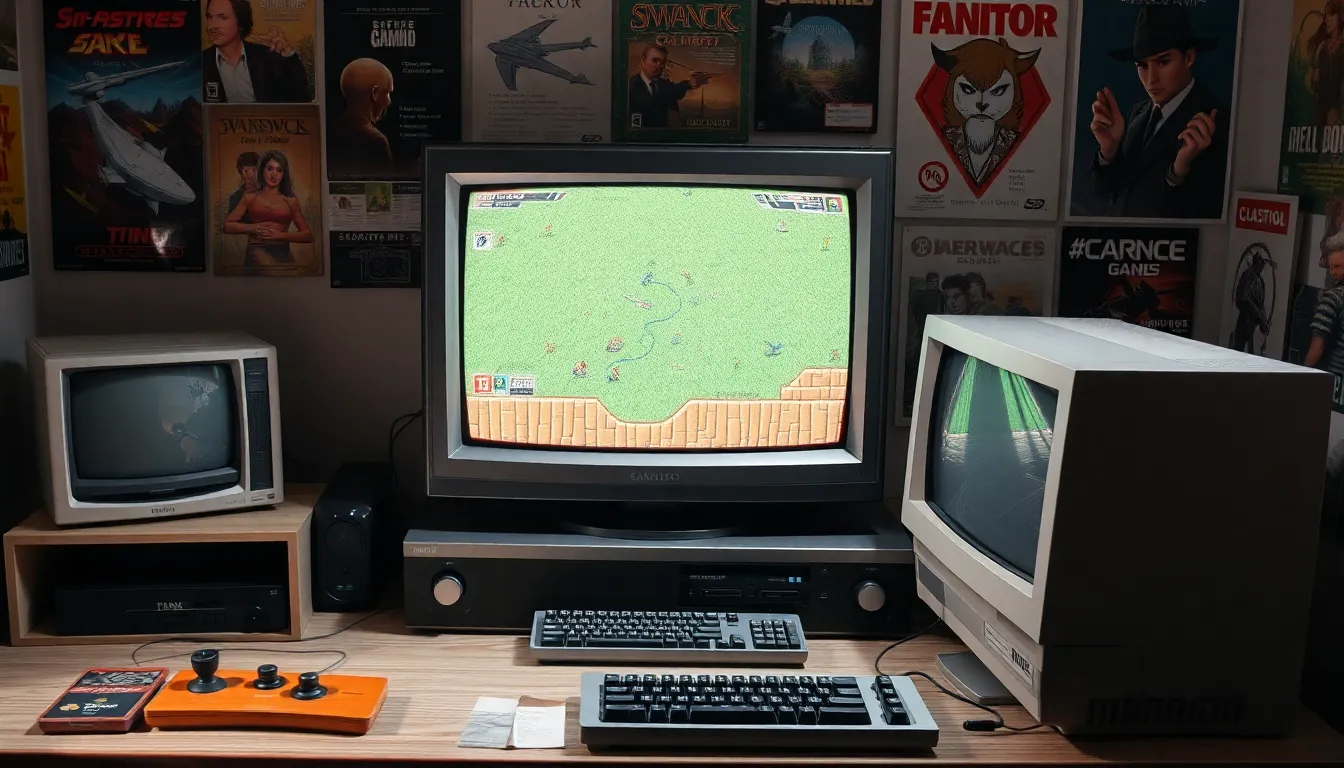In the world of gaming, few genres ignite the thrill of battle quite like real-time strategy (RTS). Picture this: you’re not just a player; you’re a cunning general orchestrating epic clashes, outsmarting opponents, and building empires—all while your coffee gets cold. Whether you’re commanding a horde of pixelated soldiers or managing resources like a pro, RTS games challenge your wits and reflexes in real-time.
But don’t worry, it’s not all serious business. Who hasn’t chuckled at a rogue unit deciding to take a scenic route instead of following orders? With every click and command, players dive into a fast-paced world where strategy reigns supreme. Ready to explore the ins and outs of this captivating genre? Let’s march into the battlefield of real-time strategy and discover what makes it a timeless favorite among gamers everywhere.
Table of Contents
ToggleOverview of Real Time Strategy
Real-time strategy (RTS) games create immersive experiences that require players to manage resources and respond to opponents instantly. Players typically assume roles as commanders, directing units while planning strategies in the moment. Quick decision-making influences the outcome of each match, reflecting the need for both tactical foresight and rapid execution.
Combat mechanics in RTS games often incorporate various unit types, each possessing unique strengths and weaknesses. Players must understand these dynamics to leverage their advantages effectively. Resource management plays a critical role, as gathering materials impacts a player’s ability to build and upgrade units. Balancing offensive and defensive strategies remains essential for success.
Game maps often feature diverse terrains, adding layers of complexity to gameplay. Navigating obstacles and utilizing terrain features can significantly affect strategic outcomes. Multiplayer modes enhance competition, requiring players to outsmart not just computer-controlled opponents but also human players, who bring unpredictable strategies.
Popular RTS titles, such as StarCraft and Age of Empires, demonstrate the genre’s capacity for depth and engagement. These games consistently push players to adapt, strategize, and rethink their approaches in response to evolving challenges. The community surrounding RTS games often fosters cooperation and competition, enhancing the overall experience.
Through continuous adaptation and refined strategies, RTS players develop their skills over time, often leading to deep personal investment in their chosen games. This genre’s distinctive blend of strategy and real-time action keeps players returning for more, solidifying RTS’s place in the gaming landscape.
History of Real Time Strategy

Real-time strategy (RTS) games have a rich history that traces back to the late 1970s and early 1980s, laying the groundwork for modern gameplay styles. These early games paved the way for engaging strategic experiences.
Early Beginnings
Pioneering titles like Stonkers and Herzog Zwei introduced players to the concept of commanding units in real-time. These games combined resource management with dynamic combat, setting the stage for innovative gameplay. Dune II emerged in 1992, establishing core mechanics that influenced future successes. It introduced elements like unit selection and a user interface that many RTS games still emulate today. The groundwork laid by these titles sparked interest and solidified the genre’s existence in gaming culture.
Evolution in Gameplay
As technology advanced, RTS games evolved significantly. Command & Conquer in 1995 amplified competitive gameplay, adding online play that allowed players to face off in real-time. Innovations included more complex unit behaviors and environmental strategies, fostering player creativity in tactics. From 1998’s StarCraft to 2000’s Age of Empires II, game design introduced various historical and futuristic settings, expanding the narrative scope. These developments shaped the genre, creating deeper engagement and enhancing player experience by encouraging strategic depth and quick decision-making.
Key Characteristics of Real Time Strategy
Real-time strategy games feature distinct characteristics that set them apart from other genres. Two of the most crucial elements include resource management and unit control.
Resource Management
Resource management stands at the core of RTS gameplay. Players gather resources like gold, wood, and food to build structures and recruit units. Timing in resource collection determines the efficiency of development. Players often face decisions about spending resources to advance or fortifying their defenses. Effective strategies arise from balancing immediate needs with long-term goals. Competition intensifies as players vie for control over valuable resources on the map. Successful players master resource allocation, ensuring they remain one step ahead of opponents.
Unit Control and Strategy
Unit control defines the tactical aspect of RTS games. Commanders issue orders to various units, each with unique strengths and weaknesses. Players adapt strategies based on unit types and their interactions within the terrain. Positioning units effectively often determines the outcome of battles. Players must react swiftly to enemy movements, utilizing their units’ abilities to gain an edge. Strategic planning extends beyond mere combat, as players consider alliances, territory control, and unit upgrades. Mastery of unit control allows for dynamic gameplay, where split-second decisions can turn the tide of battle.
Popular Real Time Strategy Games
Real-time strategy games captivate players with their dynamic gameplay and immersive worlds. Below are some iconic series that define the RTS genre.
Command & Conquer Series
The Command & Conquer series showcases some of the most influential RTS titles. Launched in 1995, this franchise popularized online multiplayer formats and introduced compelling narratives. Each installment features detailed factions, unique units, and complex mechanics. Players engage in intense battles while managing resources effectively. Tactical positioning and resource gathering drive strategy as players compete to dominate the battlefield. Notable titles include Command & Conquer: Red Alert and Command & Conquer: Generals, both of which left a lasting mark on the genre.
Age of Empires Series
The Age of Empires series immerses players in historical settings, emphasizing resource management and civilization building. Beginning in 1997, this franchise enables players to advance through different ages, unlocking technologies and units. Players choose civilizations, each with distinct strengths, shaping their gameplay approach. Engaging in multiplayer battles enhances strategic depth, requiring players to adapt their tactics based on opponents’ strengths. Notable entries like Age of Empires II and Age of Empires IV demonstrate the franchise’s evolution while retaining core mechanics that keep players engaged.
Real-time strategy games have carved a unique niche in the gaming world. Their combination of quick thinking and strategic planning offers players a truly immersive experience. With a rich history and evolving mechanics the genre continues to captivate both new and seasoned gamers alike.
As players navigate complex maps and manage resources they develop a deep connection to their in-game decisions. This personal investment not only enhances gameplay but also solidifies the genre’s place in gaming culture. Whether commanding armies or outsmarting opponents the thrill of real-time strategy remains unmatched.



